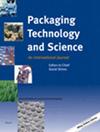Effect of Ultrasound and Freeze‐Drying to Enhance the Extraction of Phenolic Compounds in Dragon Fruit Peels and Apply Them in Edible Starch‐Based Films
IF 2.8
4区 工程技术
Q2 ENGINEERING, MANUFACTURING
引用次数: 0
Abstract
In this study, dragon fruit peels were subjected to different times (5, 10, 15, 20 and 25 min) of ultrasound pretreatment (4.870 W m−2/25°C) and then freeze‐drying (FD) (−56°C/48 h) to obtain powder particles, which underwent physical–chemical, functional and structural characterisation. Additionally, the extraction of total phenolic compound (TPC) was evaluated through ultrasound‐assisted kinetics and mechanical agitation. Finally, films based on black rice starch were developed with the addition (0.5, 1.5 and 2.5%) of dragon fruit peel powder particles, and their physical, barrier, antioxidant, structural and mechanical properties were evaluated. The results obtained showed that all particles had low water content (4.21%–6.58%) and high solubility (84.62%–88.73%) with a reduction in particle size (23.21–39.32 μm). In the extraction of TPC, the synergistic effect of the tested conditions increased efficiency, reaching 686.66 mg GAE/100 g for pretreated dragon fruit peel powder particles (25 min) in 180 min of extraction. Furthermore, the type ‘A’ crystallinity structure did not change significantly with pretreatment, but there was a reduction in peak area, reflecting on relative crystallinity, with a maximum decrease of 29.04%. The starch‐based films produced with 2.5% dragon fruit peel powder particles showed low solubility (28.72%) and low water vapour permeability (5.03 × 10−8 g mm s−1 m2 Pa), however, they contained higher levels of TPC (31.78 mg GAE/100 g film) and antioxidant activity (8.17 μmol TE/g film) that were easily migrated in aqueous medium. Furthermore, they also presented low values of tensile strength at break (3.41 MPa) and Young's modulus (4.18 MPa), as well as a high value of elongation at break (45.82%). Finally, our results highlight the potential of ultrasound as a pretreatment for FD of dragon fruit peels, paving the way for the development of rice starch‐based food packaging.超声波和冷冻干燥对提高火龙果果皮中酚类化合物的提取并将其应用于可食用淀粉基薄膜的影响
在这项研究中,火龙果皮经过不同时间(5、10、15、20 和 25 分钟)的超声波预处理(4.870 W m-2/25°C),然后进行冷冻干燥(FD)(-56°C/48 小时),得到粉末颗粒,并对其进行物理化学、功能和结构表征。此外,还通过超声辅助动力学和机械搅拌对总酚类化合物(TPC)的提取进行了评估。最后,在黑米淀粉的基础上开发了添加(0.5%、1.5% 和 2.5%)火龙果果皮粉颗粒的薄膜,并对其物理、阻隔、抗氧化、结构和机械性能进行了评估。结果表明,所有颗粒的含水量均较低(4.21%-6.58%),溶解度较高(84.62%-88.73%),粒径有所减小(23.21-39.32 μm)。在提取 TPC 的过程中,试验条件的协同效应提高了提取效率,经预处理的火龙果果皮粉颗粒(25 分钟)在 180 分钟的提取过程中达到 686.66 毫克 GAE/100 克。此外,"A "型结晶结构在预处理过程中没有发生明显变化,但峰面积有所减少,反映了相对结晶度,最大降幅为 29.04%。使用 2.5% 火龙果果皮粉颗粒生产的淀粉基薄膜具有低溶解度(28.72%)和低水蒸气渗透性(5.03 × 10-8 g mm s-1 m2 Pa),但它们含有较高水平的 TPC(31.78 mg GAE/100 g 薄膜)和抗氧化活性(8.17 μmol TE/g 薄膜),在水介质中很容易迁移。此外,它们的断裂拉伸强度(3.41 兆帕)和杨氏模量(4.18 兆帕)值较低,断裂伸长率(45.82%)值较高。最后,我们的研究结果凸显了超声波作为火龙果果皮脱模预处理的潜力,为开发基于大米淀粉的食品包装铺平了道路。
本文章由计算机程序翻译,如有差异,请以英文原文为准。
求助全文
约1分钟内获得全文
求助全文
来源期刊

Packaging Technology and Science
工程技术-工程:制造
CiteScore
4.90
自引率
7.70%
发文量
78
审稿时长
>12 weeks
期刊介绍:
Packaging Technology & Science publishes original research, applications and review papers describing significant, novel developments in its field.
The Journal welcomes contributions in a wide range of areas in packaging technology and science, including:
-Active packaging
-Aseptic and sterile packaging
-Barrier packaging
-Design methodology
-Environmental factors and sustainability
-Ergonomics
-Food packaging
-Machinery and engineering for packaging
-Marketing aspects of packaging
-Materials
-Migration
-New manufacturing processes and techniques
-Testing, analysis and quality control
-Transport packaging
 求助内容:
求助内容: 应助结果提醒方式:
应助结果提醒方式:


